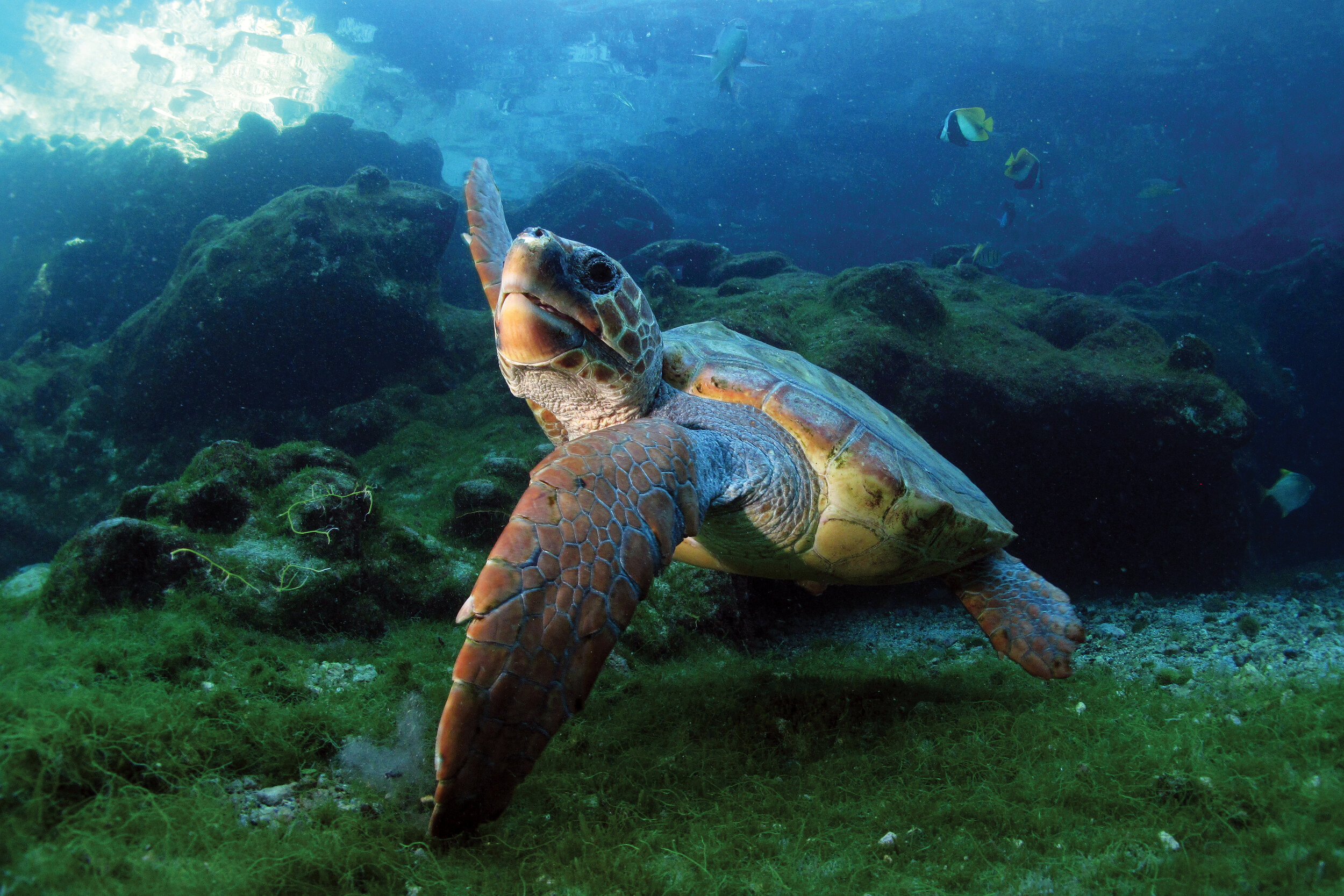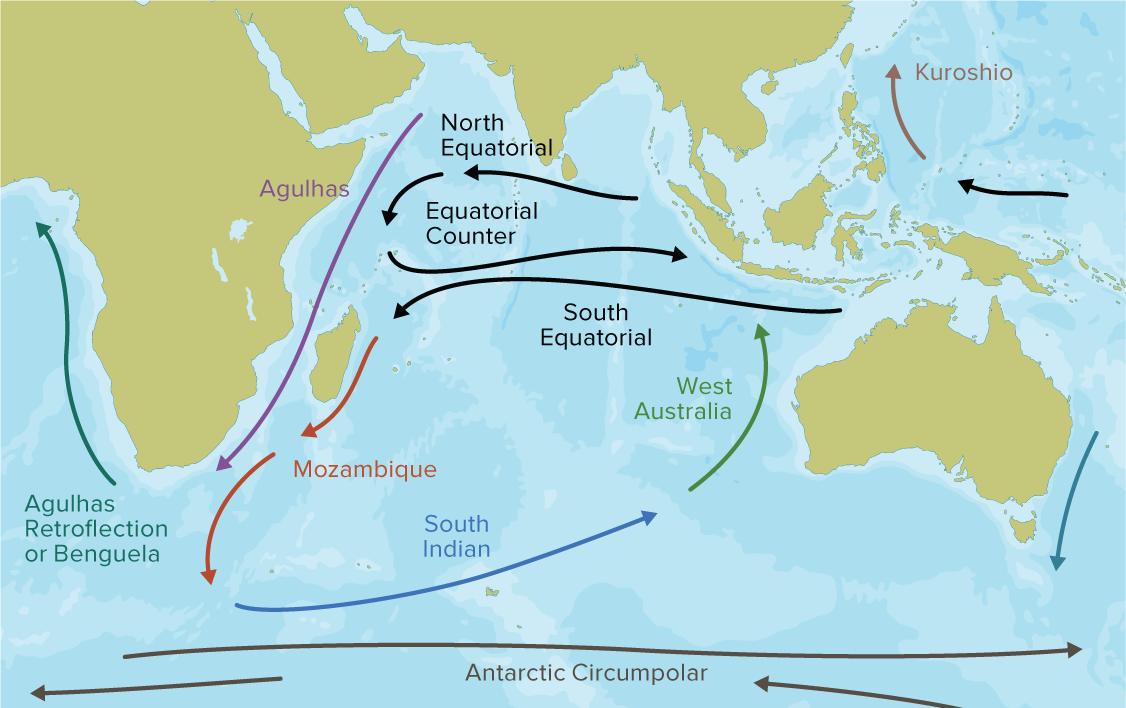Loggerhead Turtles in the Indian Ocean
By RONEL NEL, MAYEUL DALLEAU, DIANE LE GOUVELLO, MICHAEL G. HART-DAVIS, TONY TUCKER, ALAN F. REES, ANDREA D. PHILLOTT SCOTT WHITING, and SABRINA FOSSETTE
A loggerhead turtle that was accidentally hooked by a longline recovers in Kélonia’s care center (Réunion Island) after hook removal surgery. © Hendrik Sauvignet/Ocean-OBS
Recent issues of the SWOT Report have contained articles about the natural history, status, and distribution of loggerhead turtles in the Pacific Ocean (vol. XIII), as well as in the Atlantic Ocean and Mediterranean (vol. XIV), including maps of at-sea biogeography for these three large ocean biomes. Data have now been compiled from the Indian Ocean as well, to complete the first global map of loggerhead telemetry (found below). This is the unique story of Indian Ocean loggerheads, in the final chapter in this series of ocean-scale overviews.
Global distributions of the loggerhead have been divided into 10 regional management units, or RMUs (SWOT Report, vol. XII, “The Conservation Status of Loggerhead Populations Worldwide”). Four of these RMUs are in the Indian Ocean, the largest being in the northwest (figure 1). The Northwest Indian Ocean RMU surrounds the islands of Masirah (Oman) and Socotra (Yemen), where several tens of thousands of females nest. Next in rookery size is the Southeast Indian Ocean RMU, around Western Australia, which has about 2,500 nesting females annually. Then comes the Southwest Indian Ocean RMU, whose rookeries are shared between South Africa and Mozambique, with fewer than 1,000 annual nesters. These three RMUs are globally ranked as second, third, and fourth, respectively, in terms of the abundance of nesting female loggerheads. The Northeast Indian Ocean RMU, in the Bay of Bengal, is ranked as the world’s smallest rookery, with likely fewer than 50 annual nesters.
The most conspicuous aspect of the movement of loggerheads among the largest three of these rookeries, as shown by telemetry studies, is the commonly observed movement of the turtles along a north-south transequatorial axis. This movement contrasts with the east-west migrations of loggerheads typical to the northern and southern hemispheres of both the Atlantic and Pacific Oceans, where turtles typically do not cross the equator. Rather, they follow the currents of their respective north and south oceanic gyres between feeding, breeding, and developmental habitats. The atypical loggerhead movement patterns in the Indian Ocean may derive from the fact that the Indian Ocean is the only major basin that is closed in the north by a continental shelf, thereby creating unique oceanographic and atmospheric phenomena.
FIGURE 1 (AT LEFT). Map showing the Indian Ocean’s four regional management units for loggerhead turtles, with scaled circles indicating main nesting locations. FIGURE 2 (ABOVE). The ocean currents of the Indian Ocean affect both the migration of adult loggerhead turtles and the dispersion of loggerhead hatchlings.
This north-south migration of Indian Ocean loggerheads is best documented in juveniles from the Mascarene Plateau (55° S latitude), which have been tracked north to Oman and even to the Arabian Gulf, where they likely originated (SWOT Report, vol. VII, “Revealing the Secrets of Sea Turtle Migrations in the Southwest Indian Ocean”; vol. XIV, “Masirah’s Sea Turtles: History, Trends, Action, and Hope”). Unsurprisingly, adult loggerheads in Western Australia also migrate northward with the Western Australian Current, taking them to the warmer waters of the Timor and Arafura Seas. Preliminary analysis of recent tracking of neonate loggerhead turtles indicates that they do not take the same path as adults. More peculiar is that the eastern edge of the Indian Ocean loggerhead distribution seems to truncate, and the animals do not venture into the Pacific Ocean. This border is where Southeastern Indian Ocean RMU loggerheads meet those nesting in Queensland, which forage off the Great Barrier Reef (the Southwestern Pacific RMU). This apparent abrupt separation may be due to the limitations of our loggerhead tracking efforts to date, or could be caused by some other unknown factor that restricts their distribution. However, given that this RMU boundary lies roughly along a north-south line formed by the Torres Strait Islands, a narrow waterway that was previously a land bridge between Papua New Guinea and Cape York in northern Australia, it is likely a biogeographic relic from before the last ice age, when these islands and the current maze of shallow reefs and surrounding seas were above sea level.
The situation along the Southern African continent is very different. The fast-flowing Agulhas Current hugs the coast, flowing in a southwesterly direction toward the colder coast at Cape Agulhas, the continent’s southernmost point. Here it spins off partially into the Atlantic Ocean, or turns on itself and flows eastward again, to just north of the Arctic Circumpolar Current (figure 2). Modern tools such as ocean particle modeling can be used to predict the distribution of posthatchlings from the time they leave the nesting grounds. In one such model based on 2018 conditions, southwestern Indian Ocean loggerheads were shown to disperse with the Agulhas Current and end up either in the Agulhas Retroflection or in the Benguela Current (on the west coast of South Africa), with a portion ending up in the cold Southern Ocean. These locations have a high probability of mortality.
Despite those useful modeling tools, there is still considerable uncertainty about the duration of the lost years or the location of the ontogenetic shift from the pelagic phase to the neritic, nor is it known with certainty which rookery these young loggerheads would reach as adults. However, what we do observe from global sea surface temperatures is that the western Indian Ocean is a much more favorable habitat for loggerheads than either (a) the southern or southwestern edges of the African continent or (b) the southwest coast of Australia, since posthatchling turtles are unlikely to survive long- term or abrupt exposure in those cold waters. Indeed, the juvenile and adult turtles that have been tracked in the past tended to avoid the cold water of the Atlantic and Southern Oceans and appeared to be strong enough swimmers to navigate the currents and avoid the southern seas, which are notorious for their strong westerly winds and high waves.
Also curious to note is that the southwestern and southeastern Indian Ocean loggerhead rookeries are both located at about 27oS latitude, with the closest southernmost tips of their respective continental landmasses also lying at approximately the same latitude (that is, Cape Agulhas, South Africa, and a point near Albany, Western Australia, both at about 35ºS latitude, the latter being the southwesternmost point of Australia). So far south are these two rookeries, when compared with other loggerhead rookeries globally, that it is easy to assume some migration of animals into the other ocean basins, yet such migration does not seem to happen.
The release of a loggerhead from Réunion Island attracts tourists and locals. The tag on the turtle’s back will simultaneously track her migration, most probably to Oman some 4,500 kilometers away, and record ocean temperatures. © Hendrik Sauvignet/Ocean-OBS
Sea turtles that manage to avoid the troubled cold waters to the south and stay in the warmer seas of the Indian Ocean still face many challenges, two significant ones being fisheries bycatch and plastic pollution. Many of the sea turtle tracks from the southwest Indian Ocean that are presented in the global map (below) were from rehabilitated juvenile and subadult turtles caught in commercial fisheries near La Réunion. They are the lucky turtles, because they were rescued, rehabilitated at Kélonia (the sea turtle rescue center of Réunion), and released to the wild. However, an estimated 3,500 interactions between sea turtles and longline fisheries take place each year in the Indian Ocean, and whereas fishing pressures in the exclusive economic zones of most countries are managed, the high- seas impacts of turtle bycatch are believed to be shockingly high. Moreover, plastic pollution is ubiquitous throughout the Indian Ocean and presents a noteworthy threat to all age classes of loggerheads. Interestingly, studies have shown that a large amount of plastics found in the west actually originated on the eastern side of the ocean basin, where some of the most polluting countries are located. The impact of these turtle and plastic interactions has not yet been properly quantified, but unlike many of the fishing activities that are often size selective, with larger turtles being more vulnerable, plastic is an indiscriminate killer. Sea turtles of all sizes, including posthatchlings from their first days of feeding, have been seen to ingest or become entangled in plastics, which can result in malnutrition, disease, intestinal blockage, and often death.
Scientists working on loggerheads in both the Atlantic and the Pacific Oceans have generated vast amounts of original knowledge in recent decades, making those loggerheads among the best studied sea turtle populations on Earth. Meanwhile, the Indian Ocean still has many unique features to explain and rare mysteries to tackle, and her loggerhead turtles exhibit striking patterns not seen anywhere else. There is still much to learn about loggerhead turtles in this very special ocean basin, and new information is needed to implement effective cross-jurisdictional management actions for the priority threats to all Indian Ocean sea turtles.
This article originally appeared in SWOT Report, vol. 15 (2020). Click here to download the complete article as a PDF.





